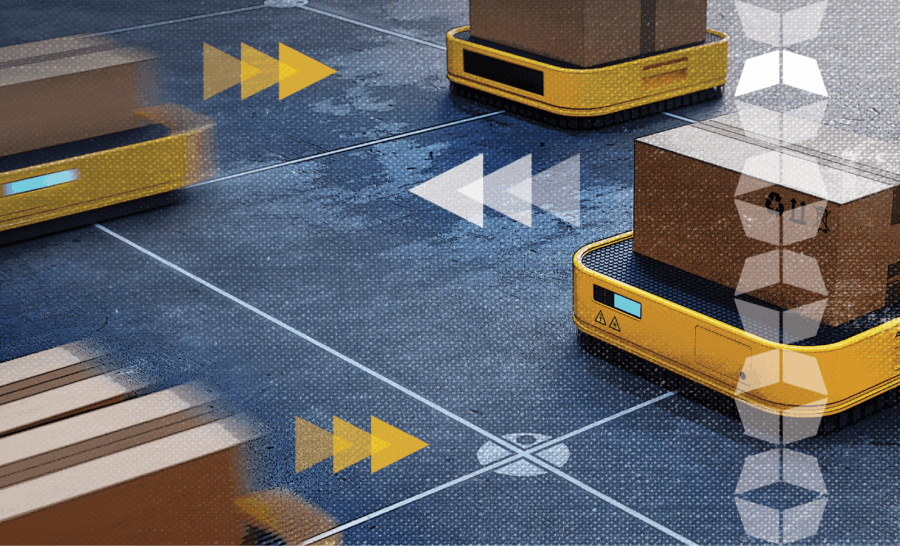Leveraging Automation in the Warehouse
In the current warehousing environment, every advantage counts.
Companies are looking for faster, more accurate, and more scalable operations to meet growing customer expectations. One of the best strategies for accomplishing those goals is to leverage warehouse automation. From conveyor systems to robotics, when companies automate, they can reduce the burden on a tight labor pool, increase throughput with better accuracy, and meet customer demands, all without compromising flexibility or quality.
Today’s warehouse automation encompasses a wide range of offerings. Companies can start small and scale up as needed, integrating new pieces along the way. With robust software platforms and warehouse technology behind the scenes, warehouse automation can operate with maximum efficiency and deliver a quick return on investment (ROI).
The pressure to automate
Warehousing is experiencing unprecedented demand from customers. The need for speed, accuracy, and flexibility has never been higher. At the same time, there’s a shrinking labor pool as boomers and GenXers retire, and the next generations gravitate toward higher tech careers. Rising operational costs only compound the pressures.
To help their workers become more efficient and improve performance, an increasing number of companies are turning to warehouse automation. A recent report confirms this: 55% of supply chain leaders are increasing their technology and innovation investments. A full 60% of those respondents intend to spend over $1 million, and 19% plan to spend over $10 million.
Core benefits of warehouse automation
Warehouse workers can greatly improve their productivity with the right use of warehouse automation. The tools can benefit many applications, from picking and packing to sortation and shipping.
Tools like fixed or handheld barcoding and RFID scanning, along with automated sorting, help boost accuracy, another key benefit of warehouse automation. Other benefits include consistency and uptime, key during seasonal surges or when short-staffed. And when a business experiences growth, warehouse automation can scale easily, keeping up with order volume and/or fulfillment complexity.
Types of automation in use today
Warehouse automation used to be limited to basic tools like conveyors and sortation systems. While those are still integral to the streamlined movement of goods, today’s warehouse automation extends well beyond those tools. At the high end of the spectrum, consider autonomous mobile robots (AMRs), for instance, which facilitate goods-to-person and eliminate employee travel time and repetitive motion.
Automated storage and retrieval systems (ASRS) are another type of automation. These fixed systems greatly enhance the space available on a warehouse floor and provide an accurate method for retrieving goods when needed. Other tools include voice and light-directed picking, which direct workers for accurate selection, and automated packaging equipment for the final 100 feet of operations. This automation can speed up box creation, sealing, labeling, and shipping.
While it’s exciting to take a turn toward a more sci-fi atmosphere, it’s essential to think of these emerging technologies as enhancements to the skilled human labor within warehousing, who continues to be the heart of logistics operations.
Automation in action: When and where it works best
Which environments benefit the most from warehouse automation? There’s a wide range of applicability, but several types of operations are well-suited for implementation. These include high-volume or high-SKU environments, often found in retailing or beverage, for instance. Automation can also be particularly useful in warehouses involving low-value manual labor and repetitive tasks. The technology can save employees from dull, mundane routines, freeing them up for more skilled jobs.
Warehouse automation also works well for facilities that operate with tight pick/pack/ship windows, which are increasingly common across the board. Additionally, regional hubs and ecommerce fulfillment centers can benefit from warehouse automation. For example, a fulfillment center struggling to meet its service-level agreements (SLAs) might benefit from a combination of AMRs and sortation technology. Combined, they could lead to reduced cycle time and more consistent performance, delivering on SLA terms and satisfying customers.
Implementing automation without overcomplication
Despite the many benefits that warehouse automation can provide, technology isn’t necessarily for every operation. Full-scale automation remains in the minority, while smaller applications are the norm. What’s critical is that companies manage to right-size their automation to operational needs.
Often, companies begin small, introducing warehouse automation in a step-by-step or phased implementation. Working with partners like WSI is essential because they know how to first assess and evaluate operations to determine the optimal place to begin. A good 3PL partner can also help roll out technology to a warehousing floor with minimal disruption to operations.
Behind all automation implementations is a software platform, which comes in a variety of forms. From orchestration platforms like a warehouse management system (WMS) to warehouse execution systems (WES), automation requires a software component to tie everything together and ensure that warehouse automation is working for maximal efficiency of operations.
The future of smart warehousing
As advanced as today’s warehouse automation already is, there’s more to come.
Robotics are making big inroads into warehousing operations, spanning the floor from receiving through shipping. Co-bots are increasingly working alongside existing employees, enhancing their every move. Expect the technology to continue to advance, optimizing what manual workers can accomplish.
Other advancements are underway through the addition of AI and machine learning. These advanced tools can assist in demand forecasting, inventory optimization, and even with robotics, making them smarter and more useful in picking and moving goods.
Automation will become increasingly data-driven, too. With smarter tools behind the scenes, expect to benefit from predictive inventory flow and labor forecasting.
While people have long floated the idea of lights-out warehousing, that scenario remains unachievable for the near future. Instead, expect warehouse automation to continue serving as a valuable partner in operations, elevating to the level of a key operational pillar. Warehouse automation can assist in delivering scalable, cost-effective, high-quality warehousing, distribution, and fulfillment – attributes that all warehouses strive to achieve.
WSI specializes in designing the right balance between human expertise, scalable processes, and smart technology. To learn more about warehousing and automation, talk to the experts at WSI.
About the Author

Amanda Loudin
Amanda Loudin is a Maryland-based freelance writer with a wide range of coverage in both the B2B and B2C arenas. Areas of focus include supply chain management/logistics, health and science, travel, and everything in between. Amanda enjoys digging into research and data to support her content development, and welcomes the opportunity to add engaging, narrative spin where appropriate. Her work includes traditional feature articles, blog posts, white papers, branded content, and executive ghostwriting.



